
views
Evaluating the Thesis Statement and Introduction

Look for an attempt to engage readers. The introduction is an excellent place to hook readers so that they will want to keep reading. Authors can accomplish this by including a question, vivid description, quote, or a jarring piece of information. Identify where the author has attempted to engage the reader and offer feedback as needed. For example, in an essay about the first day of classes at a new school, the author might engage readers by providing a vivid description of what it was like for them to walk down the hallway for the first time.

See if you can tell what the essay is supposed to be about. The introduction should provide an overview of the main subject of the essay. This overview should be brief, yet effective, so that readers will know what to expect as they continue reading. For example, if the essay is supposed to be about gun control, then the introduction should provide context for readers about this subject. This may be in the form of facts and statistics, an anecdote, or some background information on the controversy. On the other hand, a narrative essay on the first day of class at a new school would need to provide a scene from that experience or some kind of background information, such as why they had to start at a new school.
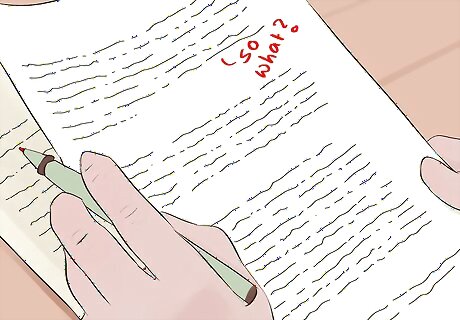
Identify the “so what?” part of the intro. Another key component of a good introduction is that it provides the readers with some motivation to care about the subject. This is often called the “so what?” part of an essay. If there is no reason for readers to be engaged with the subject, the essay will not be interesting to them. Look for an attempt to show readers why the topic should matter to them. For example, if the topic is declining bee populations, then the author might include something about how this will affect the food supply to get readers to care about the subject. If the essay is about a memorable family vacation, then the introduction might explain how this vacation changed the author’s perspective.
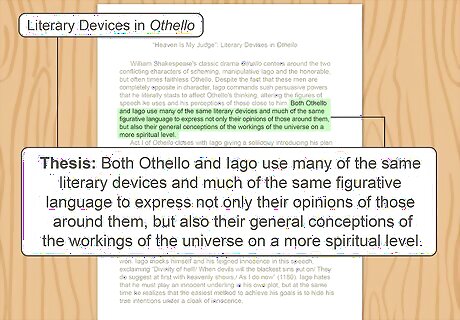
Identify the thesis statement. In many essays, the thesis is a single sentence at the end of the introduction that communicates the main point of the essay. However, in a narrative essay, there may not be a thesis until the second paragraph or page. Look for the thesis in the first couple of pages. If the thesis is absent, then make a note of this. A thesis statement includes the “what” and “why” of an essay, which means that it communicates the author’s stance and why they hold this position. For example, a paper about the benefits of recycling might include a thesis that reads, “Everyone should recycle because we have limited resources and recycling helps to conserve energy.” A narrative essay does not need to have an argument, but there should be a sentence that describes the main point of the essay, such as, “My family’s trip to Turkey taught me about different cultures, cuisines, and religions, and I learned so much about myself along the way.”
Reading the Body Paragraphs

Check that the essay includes the minimum number of body paragraphs. The assignment sheet should clearly specify the number of body paragraphs students need to receive full credit. Count the number of paragraphs in the essay you're evaluating to make sure it meets these expectations. If the assignment sheet doesn't specify otherwise, the minimum number of body paragraphs in an essay is traditionally 3. There would only need to be 3 body paragraphs if the essay is meant to be a 5 paragraph essay. If the essay is meant to be longer, then it should have about 2 body paragraphs per page. Multiply the total pages of the essay by 2 and then subtract 2 (for the intro and conclusion) to find the approximate number of body paragraphs a paper should have. For example, a 4 page essay should have about 6 body paragraphs.

Identify the topic sentence to evaluate a paragraph’s cohesiveness. A topic sentence provides the framework for the rest of the sentences in a paragraph. The most common place for a topic sentence is at the beginning of a paragraph, but it may turn up elsewhere in the paragraph as well. Look for the topic sentence and consider whether the rest of the paragraph focuses on this topic. For example, if the topic sentence reads, “Polar bears require a large amount of food to sustain their body weight,” then the rest of the paragraph should expound upon what and how much polar bears eat. For a topic sentence that reads, “The meal consisted of a hearty goat stew for the main course, and several traditional side dishes in a variety of colors, flavors, and textures,” the paragraph should provide additional details about the meal.
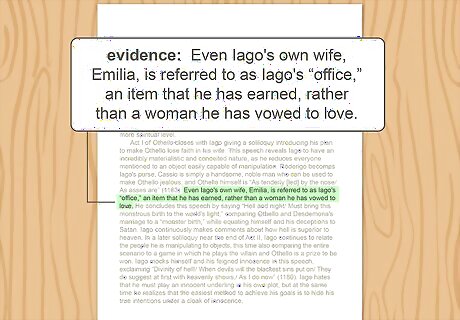
Look for evidence in each of the body paragraphs if it is required. If the essay is supposed to include sources, then any claims the author makes should be backed up with evidence. You don’t have to cite information that is widely known, or that is common sense, but anything that is based on research or that is not widely known information will require a source. For example, if a sentence reads, “Male polar bears weight between 775 to 1,200 pounds (352 to 544 kg),” then there should be a source for this information because this is not information that most people know. On the other hand, it would not be necessary to include a source for a sentence that reads, “Polar bears are large, white bears.”
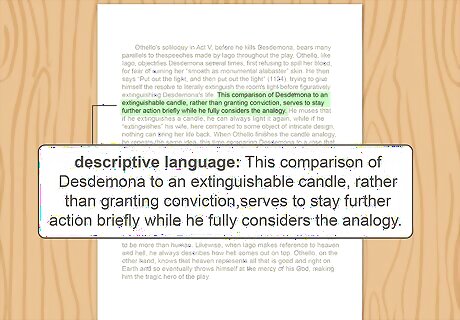
Note the use of descriptive language. If the essay is supposed to include descriptive language, such as vivid details and dialogue, then be on the lookout for it in the body paragraphs. This is a common feature of narrative essays, but descriptive language is a welcome addition to any essay. If a paragraph is describing a person, then the author might include details about the color of their hair, the sound of their voice, and the type of clothing they wore. For example, an effective descriptive paragraph might read, “Judy stood a whole head above me, but she also had an impressive afro that added about 6 inches (15 cm) to her height. She wore black Converse, ripped white jeans, a cherry red, v-neck t-shirt, and a silver locket that contained a picture of her father. Her voice was deep and raspy, as if she had smoked for 20 years, but she had never even had a puff.”

Watch for transitions between sentences and paragraphs. Transitioning from one paragraph to another and from one sentence to another is much smoother with transition words and phrases. Look for these throughout the paragraph to determine if they are used enough. Some common transition words and phrases include: Sequence: then, next, finally, first, second, third, last Cause and effect: for this reason, as a result, consequently, thus, therefore, hence Contrast or comparison: but, however, conversely, similarly, likewise, in the same way, also Example: for example, for instance, in fact, to illustrate Purpose: for this reason, to this end, for this purpose Time or place: before, after, immediately, in the meantime, below, above, to the south, nearby
Reviewing the End of the Essay

Note how the author readdresses the thesis statement. At the end of an essay, the author should restate or readdress the thesis statement in some way. It is ideal if the thesis is not repeated word-for-word. Instead, there should be a new discussion of the thesis in light of the information that the author presented in their body paragraphs. For example, if the essay was about the benefits of recycling and why it is important to recycle, then the conclusion might include a sentence that reads, “Despite all of the benefits of recycling and how easy it is to recycle, many people still don’t do it.” For a narrative essay that begins with a description of how nervous the author was to walk down the hall on the first day at a new school, the author could make a similar return to the introduction. The conclusion might include something like, “That first day was terrifying and walking down the hall felt like walking to my doom, but I learned that I was not the only one who felt that way.”

Consider what kind of impression the essay made on you. By the time you finish reading an essay, you should have some sort of takeaway from it. This could be in the form of a favorite scene, a poignant argument, or a vivid description that stuck with you. Reflect on what you have just read to determine what stood out the most. For example, at the end of a narrative essay you might be left thinking about the vivid description of a favorite family meal. An argumentative essay may leave you thinking about the moral dilemma raised by the author regarding gun control. An expository essay about polar bears might leave you with a new appreciation for their size and strength.
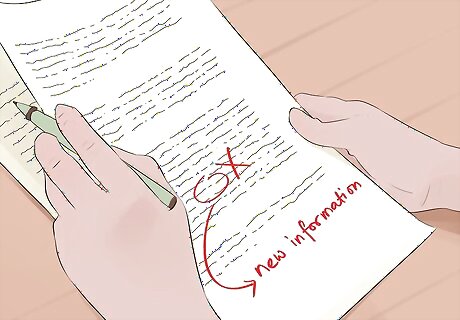
Make sure no new information is introduced. A conclusion should not include any new information. It should only summarize the ideas presented in the essay. Read over the conclusion to make sure it fulfills these requirements. If the conclusion does introduce new information, note this in your evaluation.
Evaluating Cited Sources
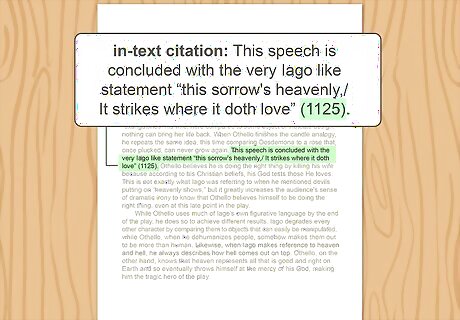
Check for in-text citations if sources were required. If the assignment specified that the essay should include in-text citations, make sure these are present and correctly formatted. Each piece of evidence cited by the writer should be accompanied by a citation. Make sure the citations are formatted according to the style guide listed on the assignment sheet, such as MLA, APA, or Chicago Style.

Verify that cited information is consistent with the original source. Compare the cited evidence used as support in the essay to the original author's ideas. Make sure the essay author is accurately presenting the information and look for signs of plagiarism. You may not have time to do this for every single piece of evidence, especially if you have a lot of students. If this is the case, you could randomly check 1-2 pieces of evidence for each essay you grade.
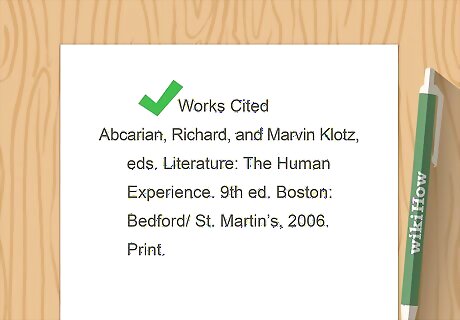
Review the works cited page to make sure it's correct. First, check that all of the cited sources are included on the works cited page. Next, make sure the citations are correctly formatted according to the specified style guide requirements. Read over the citation information to make sure it appears appropriate for the assignment. If you're in doubt about a source, use the information on the works cited page to find the original source and review it. Remember that the format should match the assigned style guide, such as MLA, APA, or Chicago Style.
Grading an Essay
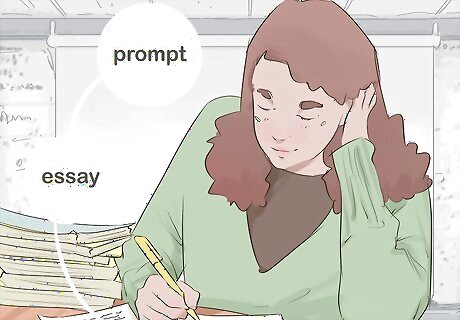
Consider how well the essay addresses the prompt or question. A well-written essay will respond to the prompt or question in a clear, effective way. If the author has not responded to the prompt, or if they have done so incorrectly, then this will have a negative impact on the entire essay. Some teachers and professors require students to rewrite essays that do not satisfy the basic requirements of an assignment. If you come across an essay like this, then you might want to meet with the student to discuss their options.
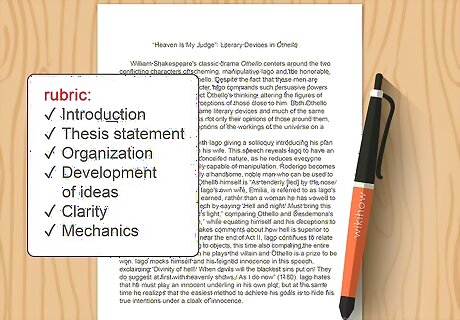
Use a rubric to structure your grading. Having a checklist to guide you as you read and grade papers is a helpful way to ensure that you do not overlook anything and it can make grading much easier. Make a list of the criteria you are looking for in an essay and assign a points value to each item. Before you assign points to the criteria, rank them in order of importance for this assignment. This will help you create a points system that relates to the goal for this assignment. It's best to give your students a copy of the rubric when you make the assignment. This allows the students to understand your grading process and expectations. Your checklist might include: Introduction Thesis statement Organization Development of ideas Clarity Mechanics

Deduct points if an item is missing, incorrect, or incomplete. Make sure that you assign a points value to each item on your checklist and decide how much you will deduct if the item is missing, incorrect, or incomplete. Then, use this to help you grade the essay as you read it. For example, if you require students to include a thesis statement in the first paragraph to outline the paper’s argument, then you might deduct 15 points if it is missing, or 10 points if it is incomplete or incorrect.














Comments
0 comment